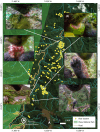Through the eyes of the Andean bear: Camera collar insights into the life of a threatened South American Ursid
- PMID: 39633786
- PMCID: PMC11615815
- DOI: 10.1002/ece3.70304
Through the eyes of the Andean bear: Camera collar insights into the life of a threatened South American Ursid
Abstract
Due to Andean bears' propensity for inhabiting challenging environments and terrain, their wild ecology remains poorly understood, especially when compared to other members of the Ursidae family. In one of the steepest, wettest regions of the Andes, the Kosñipata Valley of southeastern Peru, we attached and retrieved camera-borne collars on three wild free-ranging Andean bears. From just one longer term camera collar deployed on a single individual over a period of 4 months, we observed a variety of rare or previously undocumented natural history observations. These include courtship and mating behaviors, social interactions with conspecifics, novel dietary items of previously unrecorded fruit consumption, cannibalism, potential infanticide, the sole documented case of primate consumption, and evidence of geophagy. The wealth of novel natural history insights gained from just 4 months of camera collar data of this poorly studied species has elucidated numerous avenues warranting further investigation.
Keywords: Manu; Ursidae; cannibalism; spectacled bear; technology; telemetry.
© 2024 The Author(s). Ecology and Evolution published by John Wiley & Sons Ltd.
Conflict of interest statement
The authors declare no conflicts of interest.
Figures


Similar articles
-
Photos provide information on age, but not kinship, of Andean bear.PeerJ. 2015 Jul 16;3:e1042. doi: 10.7717/peerj.1042. eCollection 2015. PeerJ. 2015. PMID: 26213647 Free PMC article.
-
Animal-borne video systems provide insight into the reproductive behavior of the Asian black bear.Ecol Evol. 2021 Jun 19;11(14):9182-9190. doi: 10.1002/ece3.7722. eCollection 2021 Jul. Ecol Evol. 2021. PMID: 34306614 Free PMC article.
-
An Annotated Draft Genome for the Andean Bear, Tremarctos ornatus.J Hered. 2021 Jul 15;112(4):377-384. doi: 10.1093/jhered/esab021. J Hered. 2021. PMID: 33882130 Free PMC article.
-
Polar bears: the fate of an icon.Top Companion Anim Med. 2013 Nov;28(4):135-42. doi: 10.1053/j.tcam.2013.09.007. Top Companion Anim Med. 2013. PMID: 24331553 Review.
-
New insights into dietary management of polar bears (Ursus maritimus) and brown bears (U. arctos).Zoo Biol. 2022 Mar;41(2):166-175. doi: 10.1002/zoo.21658. Epub 2021 Nov 18. Zoo Biol. 2022. PMID: 34793606 Review.
References
-
- Allen, M. L. , Krofel, M. , Yamazaki, K. , Alexander, E. P. , & Koike, S. (2022). Cannibalism in bears. Ursus, 2022(33e10), 1–9. 10.2192/URSUS-D-20-00031.2 - DOI
-
- Appleton, R. , Van Horn, R. C. , Noyce, K. V. , Spady, T. J. , Swaisgood, R. R. , & Arcese, P. (2018). Phenotypic plasticity in the timing of reproduction in Andean bears. Journal of Zoology, 305(3), 196–202. 10.1111/jzo.12553 - DOI
-
- Arias‐Bernal, L. , & Yarto‐Jaramillo, E. (2018). Medicine of captive Andean bears. In Miller ‐ Fowler's zoo and Wild Animal Medicine Current Therapy Volume 9 (pp. 548–554). Elsevier. 10.1016/B978-0-323-55228-8.00078-3 - DOI
-
- Bowersock, N. R. , Gunther, K. A. , Wyman, T. , Dickinson, C. , Bergum, D. , van Manen, F. T. , & Haroldson, M. (2015). Camera collars: The evolution of tracking bears through Yellowstone. Yellowstone Science, 23(2), 68–71.
-
- Brockman, C. J. , Collins, W. B. , Welker, J. M. , Spalinger, D. E. , & Dale, B. W. (2017). Determining kill rates of ungulate calves by brown bears using neck‐mounted cameras. Wildlife Society Bulletin, 41(1), 88–97. 10.1002/wsb.733 - DOI
LinkOut - more resources
Full Text Sources

